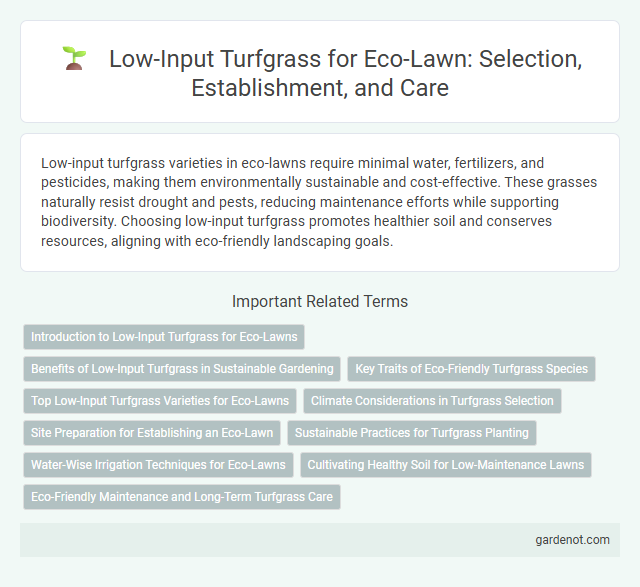Low-input turfgrass varieties in eco-lawns require minimal water, fertilizers, and pesticides, making them environmentally sustainable and cost-effective. These grasses naturally resist drought and pests, reducing maintenance efforts while supporting biodiversity. Choosing low-input turfgrass promotes healthier soil and conserves resources, aligning with eco-friendly landscaping goals.
Introduction to Low-Input Turfgrass for Eco-Lawns
Low-input turfgrass species require minimal fertilizers, water, and mowing, making them ideal for eco-lawns focused on sustainability and environmental health. These grasses often include fine fescues, buffalo grass, and Bermuda grass, known for their drought tolerance and pest resistance. By reducing maintenance demands, low-input turfgrass supports biodiversity, conserves resources, and lowers carbon emissions associated with traditional lawn care.
Benefits of Low-Input Turfgrass in Sustainable Gardening
Low-input turfgrass significantly reduces the need for water, fertilizers, and pesticides, promoting environmental sustainability in gardening. It enhances soil health and biodiversity by minimizing chemical runoff and supporting beneficial microorganisms. Such eco-lawns conserve resources while maintaining aesthetic appeal, making them ideal for sustainable landscape management.
Key Traits of Eco-Friendly Turfgrass Species
Eco-friendly turfgrass species exhibit drought tolerance, reduced fertilizer and pesticide requirements, and enhanced disease resistance, making them ideal for sustainable landscaping. These low-input turfgrasses often feature deep root systems that improve soil structure and water retention, supporting biodiversity and reducing maintenance costs. Species such as fine fescues, buffalo grass, and zoysia grass demonstrate these key traits, promoting environmental health and resource conservation.
Top Low-Input Turfgrass Varieties for Eco-Lawns
Top low-input turfgrass varieties for eco-lawns include fine fescues such as creeping red fescue, chewings fescue, and hard fescue, known for their drought tolerance and low nutrient requirements. Buffalo grass offers excellent heat resistance and minimal mowing needs, making it ideal for sustainable landscapes. Mixed blends incorporating kentucky bluegrass and perennial ryegrass enhance durability while maintaining reduced water and fertilizer inputs.
Climate Considerations in Turfgrass Selection
Selecting low-input turfgrass requires prioritizing species adapted to regional climate zones, minimizing water and fertilizer demands while enhancing resilience to temperature extremes and precipitation variability. Drought-tolerant grasses such as buffalo grass and fine fescues perform well in arid and semi-arid climates, reducing irrigation needs and promoting sustainable lawn maintenance. Incorporating climate-smart turfgrass selection supports eco-lawn goals by optimizing soil health, conserving resources, and ensuring long-term ecosystem benefits.
Site Preparation for Establishing an Eco-Lawn
Effective site preparation for establishing an eco-lawn involves thorough soil testing to determine nutrient levels and pH balance. Removing existing vegetation and aerating the soil enhances root penetration and water absorption for low-input turfgrass species. Incorporating organic matter such as compost improves soil structure, promoting sustainable growth and reducing the need for chemical fertilizers.
Sustainable Practices for Turfgrass Planting
Low-input turfgrass varieties require minimal water, fertilizer, and pesticide inputs, promoting sustainable turfgrass planting practices. Selecting drought-resistant species such as fine fescues and buffalo grass reduces environmental impact and maintenance costs. Implementing organic soil amendments and mow-high strategies further enhances turf resilience while conserving natural resources.
Water-Wise Irrigation Techniques for Eco-Lawns
Low-input turfgrass in eco-lawns thrives with water-wise irrigation techniques that reduce water consumption while maintaining healthy growth. Employing drip irrigation and sensor-based smart controllers optimizes water distribution, minimizing runoff and evaporation. Native drought-tolerant grass varieties further enhance water efficiency, promoting sustainable, low-maintenance landscaping.
Cultivating Healthy Soil for Low-Maintenance Lawns
Cultivating healthy soil is essential for establishing low-input turfgrass that requires minimal water, fertilizers, and pesticides, promoting sustainable low-maintenance lawns. Incorporating organic matter and encouraging beneficial soil microorganisms enhance nutrient cycling and improve soil structure, supporting resilient turfgrass growth. Proper soil aeration and maintaining optimal pH levels further optimize root development and nutrient uptake, reducing overall lawn maintenance efforts.
Eco-Friendly Maintenance and Long-Term Turfgrass Care
Low-input turfgrass solutions significantly reduce the need for chemical fertilizers and frequent watering, promoting eco-friendly maintenance practices. These sustainable lawns enhance soil health, support biodiversity, and minimize environmental impact over time. Proper long-term turfgrass care emphasizing organic fertilization, integrated pest management, and drought-resistant grass species ensures resilient, green landscapes with reduced ecological footprint.
Low-input turfgrass Infographic

 gardenot.com
gardenot.com